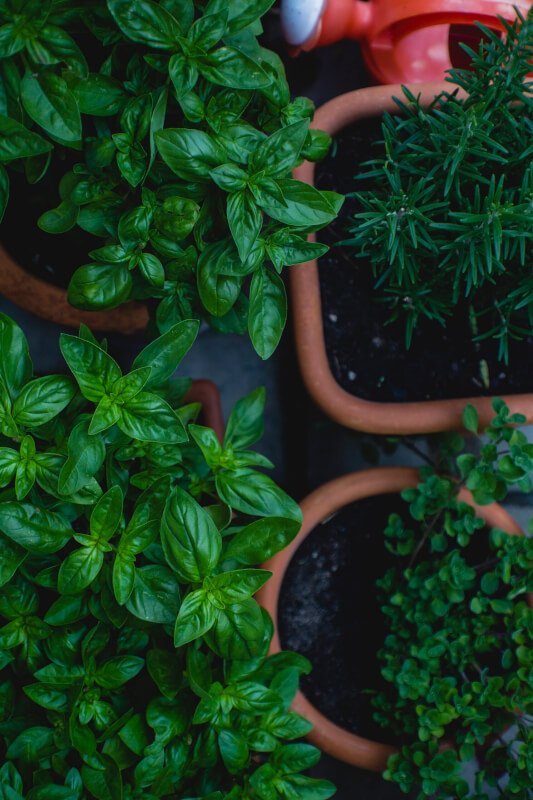If you’re looking to enhance the flavors of your healthy garden recipes, look no further than these top 10 herbs. From the refreshing taste of mint to the aromatic scent of basil, these herbs are sure to elevate your culinary creations. Whether you’re a seasoned chef or a beginner in the kitchen, incorporating these herbs into your dishes will add a burst of freshness and depth that will take your meals to the next level. So get ready to explore the world of herbs and discover new exciting flavors for your next garden recipe.

Basil
Basil is a versatile herb that comes in a variety of tasty flavors. The most common variety is sweet basil, which has a fresh and slightly peppery taste. Other varieties include Thai basil, lemon basil, and cinnamon basil, each with its own unique flavor profile.
Growing basil is fairly easy and can be done in either a garden bed or a container. The key is to provide it with plenty of sunlight and well-drained soil. Basil plants also benefit from regular pruning to encourage bushier growth.
When it comes to harvesting basil, you can start snipping off leaves as soon as the plant has reached a decent size. It’s best to pick the leaves in the morning before the sun gets too hot, as the flavor is at its peak at this time. Remember to pick from the top to encourage new growth.
In terms of using basil in garden recipes, the possibilities are endless. It pairs well with tomato-based dishes like caprese salad or homemade pasta sauce. It can also be used to flavor oils, vinegars, and even cocktails. Basil is a must-have herb in any herb garden, as its fresh and aromatic taste adds a burst of flavor to any dish.
Rosemary
Rosemary is a fragrant herb that adds a distinct and pine-like flavor to dishes. There are several varieties of rosemary to choose from, including Tuscan Blue, Arp, and Spice Island. Each variety has its own unique flavor profile, so it’s worth experimenting to find your favorite.
Growing rosemary requires full sun and well-drained soil. It’s a hardy herb that can withstand drought conditions, making it perfect for those with less-than-green thumbs. Regular pruning will help keep the plant bushy and prevent it from becoming too woody.
Harvesting rosemary is best done in the morning, when the essential oils are at their peak. Simply snip off sprigs as needed, making sure not to remove more than one-third of the plant at a time. The flavor of fresh rosemary is much more pronounced than dried rosemary, making it a great addition to garden recipes.
Rosemary works well in savory dishes like roasted meats and vegetables. It can also be used in homemade breads and infused into oils for a fragrant twist. With its robust flavor and easy growing habits, rosemary is a fantastic herb to have in your garden.
Thyme
Thyme is a versatile herb with a delicate and earthy flavor. Varieties of thyme include English thyme, lemon thyme, and caraway thyme, each with its own unique aroma and taste.
Growing thyme is relatively simple, as it thrives in well-drained soil and full sun. It’s a great option for both garden beds and containers, and its low-growing habit makes it an excellent groundcover. Regular pruning will help encourage new growth and keep the plant neat and tidy.
When it comes to harvesting thyme, you can start snipping off sprigs once the plant has established itself. The leaves are at their most flavorful just before the plant flowers. To harvest, simply cut the sprigs close to the base of the plant.
Thyme is a versatile herb that can be used in a variety of garden recipes. Its subtle flavor pairs well with roasted meats, stews, and even grilled vegetables. It can also be used to flavor oils, vinegars, and even desserts. With its delicate yet flavorful taste, thyme is a must-have herb in any garden.
Mint
Mint is a refreshing herb that comes in many varieties, including spearmint, peppermint, and chocolate mint. Each variety has its own unique taste and fragrance.
Growing mint is relatively easy, making it a great herb for beginners. It’s a perennial herb that spreads quickly, so it’s best to plant it in a container or restricted area to prevent it from taking over your garden. Mint thrives in partial shade and well-drained soil, but it can tolerate a wide range of conditions.
Harvesting mint is as simple as snipping off sprigs as needed. The flavor of mint is at its peak just before it flowers, so try to harvest it before then. To harvest, simply cut the sprigs close to the base of the plant.
Mint is a versatile herb that can be used in a variety of garden recipes. It adds a refreshing twist to salads and drinks, such as mojitos or homemade iced tea. It can also be used to flavor desserts, like chocolate mint brownies or mint-infused ice cream. With its invigorating flavor and easy-growing nature, mint is a fantastic addition to any herb garden.

Parsley
Parsley is a versatile herb that comes in two main varieties: curly parsley and Italian flat-leaf parsley. Curly parsley has a milder flavor and is often used as a garnish, while Italian flat-leaf parsley has a more robust flavor that works well in cooking.
Growing parsley is relatively easy, as it’s a hardy herb that can withstand a variety of conditions. It prefers well-drained soil and full sun, but it can also tolerate partial shade. Regular pruning will help promote bushier growth and prevent the plant from becoming too leggy.
When it comes to harvesting parsley, you can start picking leaves once the plant has reached a decent size. To harvest, simply snip off leaves as needed, making sure to leave a few at the base of the plant to encourage new growth.
Parsley is a versatile herb that can be used in a variety of garden recipes. It adds a fresh and slightly peppery flavor to dishes like soups, sauces, and salads. It can also be used as a garnish to add a pop of color to your plate. With its versatility and easy-growing habits, parsley is a must-have herb in any garden.
Cilantro
Cilantro, also known as coriander, is a flavorful herb commonly used in Mexican, Thai, and Indian cuisine. It has a distinct citrus-like taste that adds a vibrant kick to dishes.
Growing cilantro can be a bit tricky, as it has a short lifespan and tends to bolt quickly in hot weather. It prefers well-drained soil and full sun, but it can also tolerate partial shade. Sowing seeds every two weeks will help ensure a continuous harvest.
When it comes to harvesting cilantro, you can start picking leaves once the plant has established itself. To harvest, simply snip off leaves as needed, making sure not to remove more than one-third of the plant at a time.
Cilantro is a versatile herb that can be used in a variety of garden recipes. It adds a fresh and zesty flavor to salsas, guacamole, and curries. It can also be used as a garnish to add a pop of color to your dishes. With its vibrant taste and unique growing habits, cilantro is a fantastic addition to any herb garden.

Dill
Dill is a fragrant herb with feathery leaves and a distinct flavor. It adds a bright and tangy taste to dishes and pairs well with fish, potatoes, and pickles.
Growing dill is relatively easy, as it can be grown from seeds or transplants. It prefers well-drained soil and full sun, but it can also tolerate partial shade. Regular pruning will help promote bushier growth and prevent the plant from going to seed too quickly.
When it comes to harvesting dill, you can start picking leaves once the plant has established itself. To harvest, simply snip off sprigs as needed, making sure not to remove more than one-third of the plant at a time.
Dill is a versatile herb that can be used in a variety of garden recipes. It adds a bright and tangy flavor to dishes like salads, dressings, and dips. It can also be used to flavor oils, vinegars, and even homemade pickles. With its unique taste and easy-growing habits, dill is a fantastic addition to any herb garden.
Chives
Chives are a mild and onion-like herb that are commonly used as a garnish or in savory dishes. They have long, slender leaves and a delicate flavor that pairs well with potatoes, eggs, and soups.
Growing chives is relatively easy and can be done in a variety of conditions. They prefer well-drained soil and full sun, but they can also tolerate partial shade. Regular pruning will help promote bushier growth and prevent the plant from flowering too quickly.
When it comes to harvesting chives, you can start snipping off leaves as soon as the plant has established itself. To harvest, simply cut the leaves close to the base of the plant.
Chives are a versatile herb that can be used in a variety of garden recipes. They add a mild and onion-like flavor to dishes like omelets, salads, and mashed potatoes. They can also be used as a garnish to add a pop of color to your dishes. With their delicate flavor and easy-growing habits, chives are a fantastic addition to any herb garden.

Oregano
Oregano is a flavorful herb often used in Mediterranean and Italian cuisine. It has a robust and slightly peppery taste that pairs well with tomatoes, meats, and pasta dishes.
Growing oregano is relatively easy, as it’s a hardy herb that can withstand a variety of conditions. It prefers well-drained soil and full sun, but it can also tolerate partial shade. Regular pruning will help keep the plant bushy and prevent it from becoming too woody.
When it comes to harvesting oregano, you can start picking leaves as soon as the plant has established itself. To harvest, simply snip off sprigs as needed, making sure not to remove more than one-third of the plant at a time.
Oregano is a versatile herb that can be used in a variety of garden recipes. It adds a robust and slightly peppery flavor to dishes like pizza, pasta sauces, and roasted meats. It can also be used to flavor oils, vinegars, and even homemade herb blends. With its bold flavor and easy-growing habits, oregano is a must-have herb in any garden.
Sage
Sage is a fragrant herb with a distinct earthy flavor. It pairs well with poultry, pork, and root vegetables, and is often used in savory dishes.
Growing sage is relatively easy, as it’s a hardy herb that can withstand a variety of conditions. It prefers well-drained soil and full sun, but it can also tolerate partial shade. Regular pruning will help keep the plant bushy and prevent it from becoming too woody.
When it comes to harvesting sage, you can start picking leaves once the plant has reached a decent size. To harvest, simply snip off leaves as needed, making sure not to remove more than one-third of the plant at a time.
Sage is a versatile herb that can be used in a variety of garden recipes. It adds a unique and earthy flavor to dishes like roasted meats, stuffings, and soups. It can also be used to flavor oils, vinegars, and even homemade herbal teas. With its distinct taste and easy-growing habits, sage is a fantastic addition to any herb garden.
In conclusion, these top 10 herbs are perfect for adding flavor to healthy garden recipes. Each herb offers its own unique taste and aroma, making them versatile ingredients in a variety of dishes. From the fresh and peppery flavor of basil to the robust and earthy taste of sage, these herbs are sure to elevate your recipes to new heights. Whether you’re growing them in a garden bed or a container, these herbs are easy to care for and will provide you with a bountiful harvest. So why not start growing your own herb garden today and enjoy the delicious flavors that these herbs have to offer? Happy gardening!


